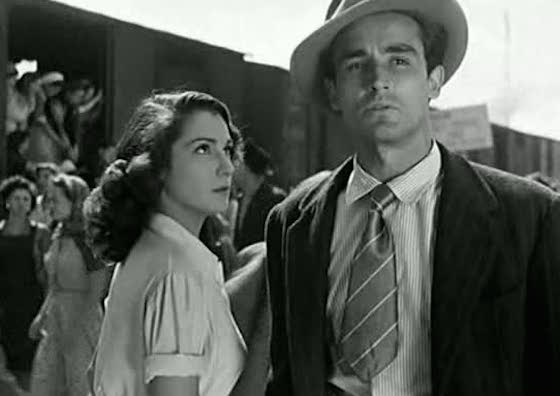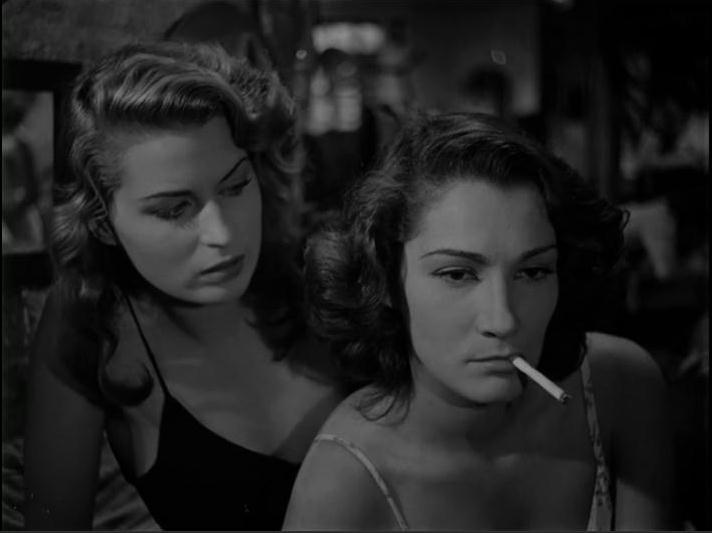![]()
 on 8/28/2024, 7:46 pm
on 8/28/2024, 7:46 pm
Conspicuously absent from this essay is the wise-guy language that Mark (following in the footsteps of Eddie Muller's persona in "Dark City") often employed as "local color" for his examination of American noir. This is a refreshing twist, but it was not to be repeated: this appears to be among the last entries added to the Where Danger Lives blog prior to it going dark until Mark's passing this past April.
Mark demonstrates a more encompassing talent for analysis here, and one likes to think that had he been more exposed to foreign noir, the impulse for upping his game that is manifested here would have continued. We were honored to show this film as part of our A RARE NOIR IS GOOD TO FIND 2 series in the spring of 2017, about four months before Mark wrote this essay. [Eddie M. would follow suit earlier this year, screening it at NC 21.] If you haven't seen it yet, you are urged to do so--and reading Mark's fine essay should further motivate you to do so...

Giuseppe De Santis’s 1949 film Bitter Rice (Riso Amaro) is powerful, exciting stuff. It’s a bewildering, multi-layered, and voyeuristic experience that borrows from so many different film styles, particularly American film noir, that it defies categorization. While it’s usually easy to red-flag films with multiple writers, this is a rare example where too many cooks did not spoil the broth: Bitter Rice credits a whopping eight different writers, and while this may account for the film’s slight case of schizophrenia, it nevertheless netted an Academy Award nomination for Best Story--and with or without accolades it’s still one hell of a movie.
It also features a gloriously charismatic new actress who electrifies the film. There’s so much, on so many different levels, in Bitter Rice worth talking about that description becomes frustrating merely for the lack of a good starting place! One certainty is that this is a movie better seen than read about; so if it weren’t nearly impossible to find a copy I’d happily advise all to stop reading and just go watch.
On a water-cooler level Bitter Rice could be described as a romantic crime piece with undercurrents of Greek fatalism, and that if it has a flaw it’s an admirably pedestrian one: it tries too hard. Instead of the typical boy/girl story we get two of each, comprising a complex romantic quadrangle.

Introductions are in order: Walter (Vittorio Gassman) is a thug and petty thief, as greasy as he is good-looking. His squeeze and sometimes-accomplice is Francesca (American actress Doris Dowling), a pretty but bitter thing who could be Ann Savage’s sister. Italian stud Raf Vallone is Marco, a cynical veteran about to drum out of the army after a decade’s service. Finally, there’s Silvana, Bitter Rice’s ball of fire. In the late forties former beauty queen Silvana Mangano made the easy transition to film; this is the picture that made her a minor international sensation.

Walter Winchell offered the understatement of the decade when he said, “Silvana Mangano is sexier than both Mae West and Jane Russell.” Winchell didn’t climb very far out on a limb, but his point is well taken; even with her unshaven arms (critics, of course, described her as “earthy”), Mangano has a positively spectacular presence: it’s nearly impossible to take your eyes off her: she simply owns the screen. She keeps her real first name intact here: the character Silvana is an “earthy”(!) peasant girl, one fully aware of her own sexuality and the powerful affect she has on men and women alike.
The character types in Bitter Rice offer its most intentional parallel to film noir, though as we’ll see later the movie channels the style in additional ways. Each of the four represent a noir archetype, though filtered through the prism of a different culture, and more importantly, a culture not dead set on aping American movies.
Walter is the stiletto-wielding thug, a schemer always looking out for his next big score. Francesca is an old-fashioned moll, smarter than she lets on but devoted to Walter simply because she has nowhere else to go. (Doris Dowling has a lot more cheek than Keechie, and Gassman is quite a few shades more nefarious than Bowie, but if this were an American product it’s very easy to imagine another Cathy O’Donnell and Farley Granger screen pairing.)
Marco looks most familiar to us: the jaded, world-weary combat veteran--but unlike his counterparts from American movies he’s not the main character. In fact, of the four leads, Marco is the least important. This is unmistakably a women’s picture, and Silvana is the femme fatale. The universe of Bitter Rice has at its center this incredible eighteen-year-old — in two key scenes she simply dances what she calls the “boogie-woogie” while a crowd of onlookers cheer her every move; the filmmakers take pause as well, allowing viewers to simply bask in her aura. It’s the sort of raw moment that could never happen in a studio picture (unless, somehow, Margarita Cansino had been allowed to stand in for Rita Hayworth).
The story itself is novel, though it kicks off (and closes) by putting a fresh spin on the noir trope of voiceover narration. Opening to a black screen and a disembodied voice, in pure semi-documentary style, it tell us that although few outsiders know it, rice is grown in the northern part of Italy. Each May, trains shuttle women from the south to work in the rice fields. It’s strictly women’s work too: male hands are too large, too clumsy, and thys of no use. The pay isn’t much, but in a country still recovering from war any work is welcomed, and these women are happy to have it; there are plenty of those who would give their right arm for a chance to work the paddies. In time, the disembodied voice coalesces into a face, and we realize that the man speaking is, in fact, a radio announcer at the Rome station, doing a story on the women boarding the train for a season of wet toil under the hot sun of the Po Valley.

Meanwhile, Walter and Francesca are fleeing the cops with a stolen diamond necklace in hand: they wind up at the train station among the hubbub of the departing workers. Walter slips the jewelry to Francesca and shoves her towards the train: she’s to lay low up north until the heat dies down. She meets Silvana just after boarding, and the pair form an tense friendship after Silvana discovers the secret necklace.
Instead of turning her in, Silvana is fascinated enough by the streetwise older girl to help her secure a job alongside the other women. As the film carries us from Rome to the unending wetness of the rice paddies it takes on an entirely different tone. The men are momentarily forgotten as we enter a world that seems pulled directly from the social-realist propaganda posters of the Soviet Union. The large group of women bond through the (positive) experience of toil--hunched under the sun in headscarves and large straw hats--the affectionate Americanism of the film’s opening giving way to something far more in line with Marxism, and the universality of the film’s romantic melodramatics give way to the immediacy of neorealism, of a singular time and a place.

Throughout the second act the characters of Francesca and Silvana continue to develop while the powerhouse visuals actually get stronger, forsaking gritty social realism for something that at times approaches artfully rendered heroic realism. One scene in particular finds the women carrying on a dramatic conversation through song, the only form of communication permitted while they work. The effect is at once vividly operatic and quite moving. Another expressionistic scene shows the terrible consequences that occur when the women are forced to weed the paddies during a torrential rainstorm. Both scenes blend sound and image in a visceral way that brings to mind the work of Terence Malick.
As Francesca and Silvana get to know each other better, the bonds of their tenuous friendship are repeatedly tested, broken, and formed anew. This nature of this friendship provides the film’s most engrossing strand of dramatic tension--particularly when it is threatened by the competing burdens of the necklace and the girls’ romantic entanglements. As the story unfolds Francesca’s and Silvana’s personalities have a transformative affect on each other, and both come to covet what the other has. In Francesca’s case, work and camaraderie with the other woman have helped her grow up. She begins to appreciate the value of a day’s labor, while Silvana becomes something altogether more dangerous--her eyes opened to the possibility of an easier, sexier life with Walter and the necklace, far away from the rice paddies.
Bitter Rice’s final act returns to the roots of its first, as Walter journeys north to brace Francesca and recover the necklace--though he comes bearing an important piece of information that will have a profound affect on the film’s denouement. By its final moments, it becomes practically indistinguishable from American noir. The romantic entanglements are reinvigorated by Walter’s presence, and he tries to manipulate each of the girls to his own ends while keeping Marco safely at bay.
Walter dreams up a new scheme, and with the allure of the necklace and promises of love and a life together he convinces Silvana to help him--by betraying the community of rice workers. Before the end titles roll we’ll witness fisticuffs, a failed heist, a gun battle, and a symbolically gruesome four-way showdown amidst hanging beef carcasses in a cold meat locker--events all tragically shepherded by fate’s relentless determination to see justice done. In the end there is tragedy and there are victims, but not necessarily unforgivable ones.

One of the many reasons we are drawn to foreign film in general, and neorealism in particular, is that such movies can offer a rejuvenating breather from the redundancy of Hollywood studio products and their comfortably predictable stories. Yet even as it does this, Bitter Rice utilizes a surprisingly familiar structure; anyone well versed in the studio-era film noir will identify the plot threads, and will see how, in pure Hollywood fashion, they ultimately weave together--allowing no character to escape either the crushing judgment of fate and/or the mistakes of their past. And through this conscientious fusion of American idiosyncrasy and Italian style--whether employed as criticism of American values or not--we are met with a film experience that is both viscerally exciting and strangely, undeniably familiar.
Responses